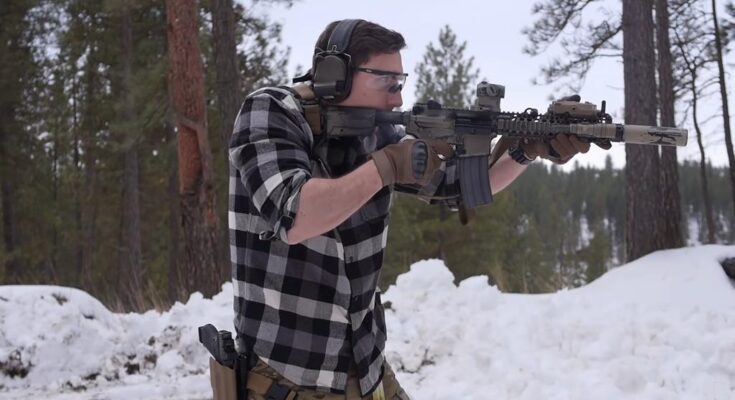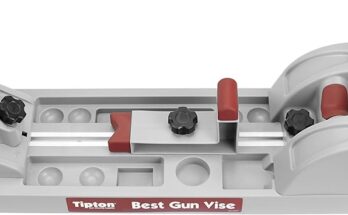Yes, you can suppress an AR-15. You need a suppressor, proper threading, and a tax stamp.
Suppressing an AR-15 can significantly reduce noise and recoil, making shooting more comfortable and discreet. A suppressor, also known as a silencer, attaches to the muzzle of the rifle. To install one, the barrel must have the correct threading. You also need to comply with legal requirements, including obtaining a tax stamp from the Bureau of Alcohol, Tobacco, Firearms and Explosives (ATF).
This process involves background checks and paperwork. Following these steps ensures your AR-15 is legally and effectively suppressed, enhancing your shooting experience while adhering to regulations.

Credit: www.youtube.com
Introduction To Ar-15 Suppression
The AR-15 is a popular firearm among enthusiasts. Many owners want to know about suppressing it. Suppression can reduce noise and recoil. This blog will guide you through the process. Learn about the benefits and requirements.
What Is A Suppressor?
A suppressor is a device attached to the firearm’s barrel. It reduces the noise and muzzle flash. Many call it a silencer. But it doesn’t make the gun completely silent. It significantly decreases the sound level. Suppressors also reduce recoil, making shooting more comfortable.
| Feature | Description |
|---|---|
| Noise Reduction | Reduces gunshot noise |
| Recoil Reduction | Lessens the kickback |
| Muzzle Flash | Minimizes visible flash |
Why Suppress An Ar-15?
Suppressing an AR-15 has many advantages. It makes shooting more enjoyable. Here are some reasons:
- Hearing Protection: Lower noise means less risk of hearing loss.
- Better Accuracy: Reduced recoil helps in maintaining aim.
- Less Disturbance: Quieter shots don’t disturb neighbors or wildlife.
- Improved Communication: Easier to talk with others at the range.
Adding a suppressor to your AR-15 enhances your shooting experience. It makes the firearm more user-friendly.
Legal Considerations
Suppressing an AR-15 involves understanding various legal factors. You must comply with federal laws, state regulations, and obtain a tax stamp. Each of these steps is crucial for legal compliance.
Federal Laws
Suppressors, also known as silencers, are regulated by federal law in the United States. The National Firearms Act (NFA) governs these regulations. You need to follow strict guidelines to legally own a suppressor.
- You must be at least 21 years old.
- You need to pass a background check.
- You must submit fingerprints and photographs.
Once approved, you will receive a tax stamp. This process can take several months.
State Regulations
Each state has its own set of rules regarding suppressors. Some states allow them, while others do not.
| State | Suppressor Legality |
|---|---|
| Texas | Legal |
| California | Illegal |
Check local laws to ensure compliance. This information can often be found on state government websites.
Obtaining A Tax Stamp
To legally own a suppressor, you must obtain a tax stamp. This involves several steps:
- Fill out ATF Form 4.
- Submit fingerprints and photographs.
- Pay a $200 tax.
- Wait for approval.
Keep the tax stamp with the suppressor. This proves your legal ownership.
Types Of Suppressors
An AR-15 can be suppressed with the right suppressor. Choose from direct-thread, quick-attach, or integrally suppressed options. Essential items include a quality suppressor, appropriate mounting system, and proper tools.
When it comes to choosing a suppressor for your AR-15, there are two main types to consider: Direct Thread Suppressors and Quick-Detach Suppressors.
Direct Thread Suppressors
- Threaded directly onto the barrel
- Simple and secure attachment
- Lightweight and compact design
Quick-detach Suppressors
- Easy and quick to attach and detach
- Allow for rapid transition between suppressed and unsuppressed shooting
- Offer versatility for different shooting scenarios
Credit: www.quora.com
Choosing The Right Suppressor
Choosing the right suppressor for your AR-15 is essential. The right suppressor affects performance and shooting experience. We will explore key factors to consider. These include material, durability, sound reduction, weight, and size.
Material And Durability
Suppressors are made from various materials. Common options are stainless steel, aluminum, and titanium.
| Material | Pros | Cons |
|---|---|---|
| Stainless Steel | Highly durable, heat-resistant | Heavier than others |
| Aluminum | Lightweight, affordable | Less durable, less heat-resistant |
| Titanium | Extremely durable, lightweight | More expensive |
Sound Reduction
The primary purpose of a suppressor is to reduce noise. Different suppressors offer various levels of sound reduction. Look for decibel reduction ratings. A higher rating means more noise reduction. Some suppressors reduce noise more effectively.
Weight And Size
Weight and size impact maneuverability and ease of use. A lighter suppressor may be preferable for long shooting sessions. Consider the balance between weight and performance. Below is a summary:
- Lightweight: Easier to handle, may reduce durability
- Compact Size: Enhances maneuverability, may affect noise reduction
- Full-Size: Better noise reduction, may add weight
Required Equipment
Suppressing an AR-15 requires specific equipment. This gear ensures proper attachment and optimal performance. Let’s dive into the necessary items.
Threaded Barrel
A threaded barrel is essential for mounting a suppressor. The threads allow for secure attachment. Ensure your AR-15 barrel is threaded correctly. Common thread sizes are 1/2×28 for .223/5.56 calibers. Verify your barrel’s thread pitch to match your suppressor.
Suppressor Host
The suppressor host refers to the AR-15 platform. It needs to be compatible with your suppressor. Some hosts are more suppressor-friendly. Check for adjustable gas blocks. This helps manage the increased back pressure. A suppressor-ready host optimizes performance.
Mounting Accessories
Various mounting accessories assist in attaching your suppressor. These include:
- Adapters: Ensure proper fit between the barrel and suppressor.
- Flash Hiders: Reduce muzzle flash while supporting suppressor attachment.
- Muzzle Brakes: Minimize recoil and enhance suppressor stability.
Ensure all accessories are compatible with your AR-15 and suppressor. This ensures a secure, optimal fit.
Installation Process
Suppressing your AR-15 can reduce noise and improve shooting comfort. The installation process requires careful steps. Follow this guide to ensure a smooth and safe installation.
Preparing Your Ar-15
First, ensure your AR-15 is unloaded and safe. Remove the magazine and check the chamber. Place your rifle on a stable surface. Gather all necessary tools and materials.
Key tools include:
- Wrench
- Thread locker
- Cleaning kit
Clean the barrel threads to remove debris. This ensures a secure fit for the suppressor. Inspect the barrel for any damage.
Attaching The Suppressor
Start by applying thread locker to the barrel threads. This helps secure the suppressor. Carefully screw the suppressor onto the barrel. Use a wrench to tighten it.
Ensure the suppressor is aligned with the barrel. Misalignment can cause damage. Double-check the fit and tightness.
Maintenance And Care
Maintaining your AR-15 suppressor is crucial for optimal performance. Regular care ensures longevity and reliability. This section covers how to clean, store, and inspect your suppressor.
Cleaning The Suppressor
Cleaning a suppressor is essential. Carbon and residue build-up can affect its efficiency. Use a suppressor cleaning solution to soak the parts. A brush helps remove stubborn deposits.
- Disassemble the suppressor.
- Soak parts in cleaning solution.
- Scrub with a brush.
- Rinse and dry thoroughly.
Regular cleaning prevents malfunction. Follow the manufacturer’s guidelines for best results.
Storing Your Suppressor
Proper storage prevents damage. Always store your suppressor in a cool, dry place. Humidity can cause rust and corrosion.
A silica gel pack can help absorb moisture. Use a protective case to avoid physical damage. Keep the suppressor away from dust and debris.
Regular Inspections
Inspect your suppressor regularly. Look for signs of wear and tear. Check for loose or damaged parts. Ensure the baffles are in good condition.
- Disassemble the suppressor.
- Examine each component.
- Replace any worn parts.
- Reassemble carefully.
Regular inspections help catch problems early. This ensures your suppressor remains safe and effective.
Performance And Benefits
Suppressing an AR-15 can significantly improve your shooting performance. The benefits extend beyond just noise reduction. You’ll experience better recoil management and an enhanced shooting experience. Below, we explore these aspects in detail.
Noise Reduction
A suppressor can greatly reduce the noise produced by an AR-15. This makes shooting more comfortable for you and others around. Noise reduction protects your ears from loud gunshots. It also helps in maintaining a quieter shooting environment.
Recoil Management
Suppressors help in managing recoil effectively. They reduce the kickback felt with each shot. This makes it easier to maintain your aim. With less recoil, your follow-up shots will be more accurate. This is especially helpful in rapid-fire situations.
Enhanced Shooting Experience
Using a suppressor enhances your overall shooting experience. The reduced noise and recoil make shooting more enjoyable. You will feel less fatigue during long sessions at the range. A suppressor also makes it easier to communicate with others while shooting.
- Less noise means better communication.
- Reduced recoil improves accuracy.
- Enhanced experience leads to longer, more enjoyable sessions.
Common Myths And Misconceptions
Many people hold misconceptions about suppressing an AR-15. These myths can confuse and mislead. Let’s debunk some common myths and misconceptions.
Legal Myths
One common myth is that suppressors are illegal for civilians. In reality, suppressors are legal in many states. You need to follow specific regulations.
Another myth is that anyone can buy a suppressor online. This is false. You need to pass a background check. You also need to pay a tax stamp.
Performance Myths
Many think suppressors make guns silent. This is a myth. Suppressors reduce noise but do not eliminate it.
Some believe suppressors affect bullet speed. In fact, they usually do not. They can even improve accuracy.
| Myth | Fact |
|---|---|
| Suppressors are illegal. | Legal in many states. |
| Anyone can buy a suppressor online. | Requires background check and tax stamp. |
| Suppressors make guns silent. | Reduce noise, not eliminate it. |
| Suppressors affect bullet speed. | Usually do not affect speed. |

Credit: www.silencercentral.com
Frequently Asked Questions
Can I Legally Suppress An Ar-15?
Yes, you can legally suppress an AR-15. However, you must comply with the National Firearms Act (NFA) regulations. This includes obtaining a tax stamp and passing a background check.
What Is Needed To Suppress An Ar-15?
To suppress an AR-15, you’ll need a compatible suppressor, a tax stamp, and possibly an adapter. Ensure the suppressor fits your AR-15 model.
How Do I Get A Suppressor For My Ar-15?
To get a suppressor, purchase it from a licensed dealer. Then, submit ATF Form 4, pay the tax stamp fee, and wait for approval.
Is A Suppressor Worth It For An Ar-15?
A suppressor is worth it if you want to reduce noise and recoil. It improves shooting comfort and hearing protection.
Conclusion
Suppressing an AR-15 is possible with the right tools and knowledge. Ensure you follow all legal requirements. Invest in a quality suppressor and seek professional advice. This enhances safety and shooting experience. Understanding the process helps you make informed decisions.
Enjoy your shooting activities responsibly and legally.
Related Post:



